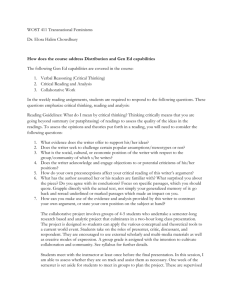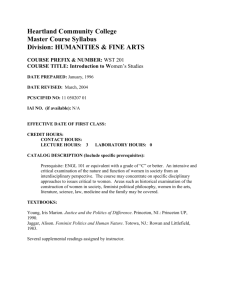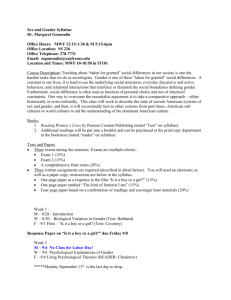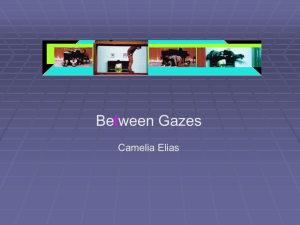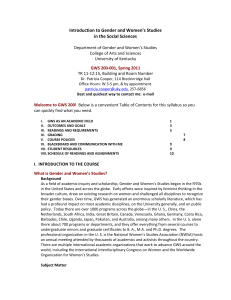WS 375: Women and Visual Culture
advertisement
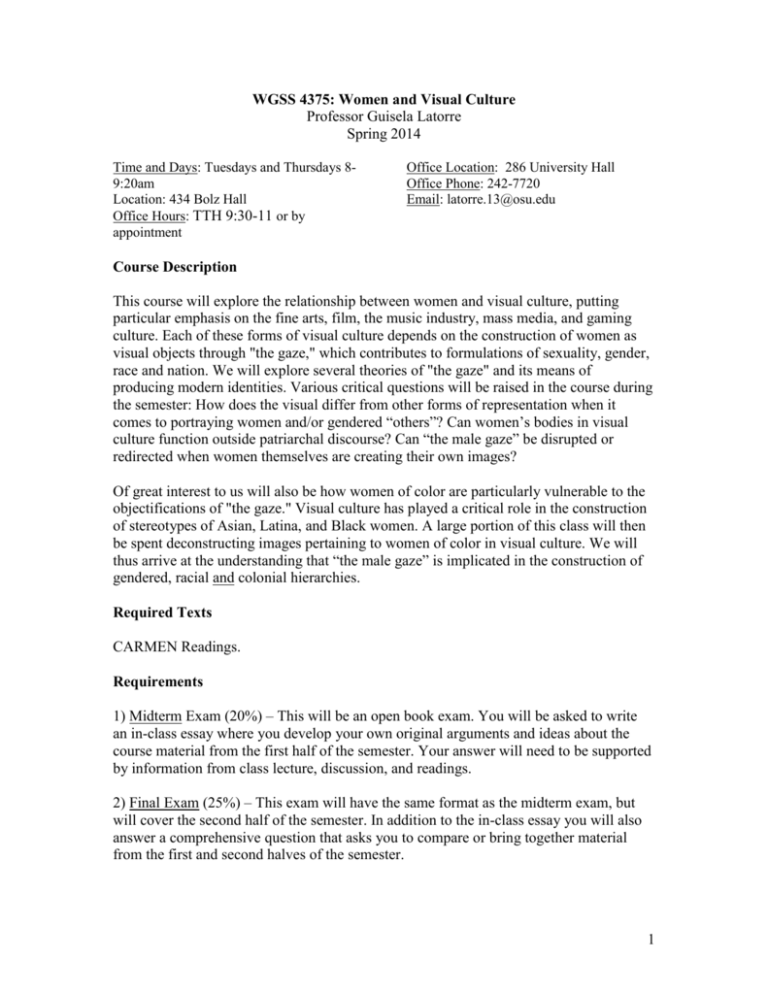
WGSS 4375: Women and Visual Culture Professor Guisela Latorre Spring 2014 Time and Days: Tuesdays and Thursdays 89:20am Location: 434 Bolz Hall Office Hours: TTH 9:30-11 or by appointment Office Location: 286 University Hall Office Phone: 242-7720 Email: latorre.13@osu.edu Course Description This course will explore the relationship between women and visual culture, putting particular emphasis on the fine arts, film, the music industry, mass media, and gaming culture. Each of these forms of visual culture depends on the construction of women as visual objects through "the gaze," which contributes to formulations of sexuality, gender, race and nation. We will explore several theories of "the gaze" and its means of producing modern identities. Various critical questions will be raised in the course during the semester: How does the visual differ from other forms of representation when it comes to portraying women and/or gendered “others”? Can women’s bodies in visual culture function outside patriarchal discourse? Can “the male gaze” be disrupted or redirected when women themselves are creating their own images? Of great interest to us will also be how women of color are particularly vulnerable to the objectifications of "the gaze." Visual culture has played a critical role in the construction of stereotypes of Asian, Latina, and Black women. A large portion of this class will then be spent deconstructing images pertaining to women of color in visual culture. We will thus arrive at the understanding that “the male gaze” is implicated in the construction of gendered, racial and colonial hierarchies. Required Texts CARMEN Readings. Requirements 1) Midterm Exam (20%) – This will be an open book exam. You will be asked to write an in-class essay where you develop your own original arguments and ideas about the course material from the first half of the semester. Your answer will need to be supported by information from class lecture, discussion, and readings. 2) Final Exam (25%) – This exam will have the same format as the midterm exam, but will cover the second half of the semester. In addition to the in-class essay you will also answer a comprehensive question that asks you to compare or bring together material from the first and second halves of the semester. 1 3) Discussion and Participation (25%) – Thursdays will be mostly dedicated to discussion and in-class dialogue. It is thus crucial that you complete the assigned readings on that day in order to prepare for class on Thursdays. You will not be able to pass WGSS 4375 without actively participating in our in-class dialogues and by demonstrating that you have done the readings. 4) Research Paper on Women of Color and Visual Production (20%): For this paper you will write a research-based analysis on a current visual production (movie, play, art exhibition, fashion spread, music videos, etc.) This analysis should focus on the racial and gender representations in your chosen production. Further details and guidelines for this paper will be provided during the second week of the quarter. 5) Mini-Presentation (10%): I will assign you one of our readings from the syllabus so that you can lead discussion on that text. Using PowerPoint, you will outline the main points of the reading, select images to go along with your presentation and formulate a series of discussion questions for the class. Extra Credit You may earn extra credit in this class by attending one or two events on or off campus that relate to the topic of women and visual culture. You will then be required to write a 2 to 3-page report on these events. This report, due on the day of our final exam, will need to include a summary of the event you attend and an explanation of how it relates to our class. More information will be provided during class lecture and discussion. Attendance Policy You are allowed two unexcused absences this semester without affecting your course grade. I will subtract half a letter grade off your final grade in class for each additional absence you may incur. For those of you who leave class early or arrive late, you will earn only partial attendance credit for that day. In addition, you are still responsible for all the course material you miss during your absences (excused or unexcused.) Plagiarism Plagiarism is a serious offense that is strictly forbidden. Use of another's work without proper documentation, intentional or not, is tantamount to plagiarism and thus unacceptable. For information on plagiarism and how to avoid it, see the following link: http://cstw.osu.edu/writingCenter/handouts/research_plagiarism.cfm Class Discussion Etiquette As many courses on feminism, gender and ethnic studies do, this class deals with numerous controversial and sensitive issues that often elicit heated discussion. I expect that a number of you will disagree with the opinions expressed in the class readings and 2 discussion. I certainly expect you to express your honest opinion. Nevertheless, all inclass dialogue needs to happen within an atmosphere of civil intellectual exchange and mutual respect. Personal attacks, heckling, loud speaking and cutting people off before they are done talking will not be permitted. Personal Emergencies If you experience a personal emergency during this quarter such as a serious illness, death in the family, accidents and/or other unforeseen circumstances that may potentially prevent you from completing coursework in this class, please contact me immediately. I will deal with these emergencies on a case-to-case basis. Be aware, however, that in most cases you will need to provide documentation for any reported emergency in order to for me to help you. Note that social events such as weddings, vacations, quinceañeras and barmitzvahs, to cite just a few examples, are not considered emergencies. Note on PowerPoint Presentations I use PowerPoint as a pedagogical tool in almost all my lectures. It is important, however, that you not misunderstand the function that my PowerPoint presentations have in this course. These are meant to facilitate in-class note taking by providing you with general outlines for each lecture. Nevertheless, I do not share my PowerPoint slides outside of class, nor do I post them on the web. Moreover, it is not sufficient for you to just write down what is up on the screen because these outlines will merely contain keywords and ideas that will not make much sense without the oral explanations and discussions that we will have in class. Technology Policy Please turn off all cell phones during class. Texting is strictly forbidden. Laptops, iPads and tablets are permitted only for the purposes of note-taking and viewing articles assigned for class during discussion. If I find that you are doing anything else with these devices during class, you will be automatically deducted one letter grade off your final class grade. Class Calendar Week 1 January 7 – General Introduction January 9 – Women, Gender and Visual Culture Week 2 January 14 – The Gaze and the Female Body January 16 – Discussion 3 John Berger, “Ways of Seeing,” in The Feminism and Visual Culture Reader, 4952. Laura Mulvey, “Visual Pleasure and Narrative Cinema,” in The Feminism and Visual Culture Reader, 57-65. Judith Butler, “Performative Acts and Gender Constitution: An Essay in Phenomenology and Feminist Theory,” in The Feminism and Visual Culture Reader, 482-492. Week 3 January 21 – Art January 23 - Discussion Linda Nochlin, “Why have There been No Great Women Artists?” in The Feminism and Visual Culture Reader, 263-267. Janet Wolff, “Reinstating Corporeality,” Feminine Sentences, 120-141. Week 4 January 28 – Film – Proposal for visual production paper due January 30 – Discussion Sylvia Harvey, “Woman’s place: the absent family of film noir,” Women in Film Noir, 22-34. Eric Lott, “The Whiteness of Film Noir,” American Literary History, 542-565. Brian Gallagher, “ ‘I Love You Too’: Sexual Warfare & Homoeroticism in Billy Wilder’s Double Indemnity,” Literature Film Quarterly, 237-246. Week 5 February 4 – Film Film Screening – Double Indemnity (1944), starring Fred McMurray and Barbara Stanwyck, directed by Billy Wilder. February 6 – Discussion Week 6 February 11 – Television and Mass Media February 13 - Discussion Marian Meyers, “African American Women and Violence: Gender, Race and Class in the News,” Critical Media Studies, 95-118. John Howard and Laura Prividera, “The Fallen Woman Archetype: Media Representations of Lynndie England, Gender and the (Ab)uses of U.S. Female Soldiers,” Women’s Studies in Communication, 287-311. Week 7 February 18 – Review 4 February 20 – Midterm Exam Week 8 February 25 – The Music Industry February 27 – Discussion Gillian Rodger, “Drag, Camp and Gender Subversion in the Music and Videos of Annie Lennox,” Popular Music, 17-29. Alyssa Robillard, “Music videos and sexual risk in African American adolescent girls: gender, power and the need for media literacy,” American Journal of Health Education, 93-103. Week 9 March 4 – Gaming, Digital Media, and Gender – Outline and bibliography for visual production paper due March 6 - Discussion Jennifer Jenson and Suzanne de Castell, “An ethnographic study of gender and digital gameplay,” Feminist Media Studies, 167-179. Karla Mantilla, “Gendertrolling: Misogyny Adapts to New Media,” Feminist Studies, 563-580. Claudia Herbst, “Virtual Females and the Sexing of War,” Feminist Media Studies, 311-324. Spring Break – March 10-14 No Classes Week 10 March 18 – Racialized Visions: Asian/Asian-American Women in the Media March 20 - Discussion Gina Marchetti, “White Knights in Hong Kong: Love is a Many-Splendored Thing and The World of Suzie Wong,” in Romance and the “Yellow Peril”, 109124. Eugenia Kaw, “Medicalization of Racial Features: Asian American Women and Cosmetic Surgery,” Medical Anthropology Quarterly 7:1 (March 1993): 74-89. Week 11 March 25 – Racialized Visions: Latinas on Film March 27 - Discussion Rosa Linda Fregoso, “Lupe Vélez: Queen of the Bs,” in From Bananas to Buttocks: The Latina Body in Popular Film and Culture, 51-68. Shari Roberts, “ ‘The Lady in the Tutti-Frutti Hat’: Carmen Miranda, a Spectacle of Ethnicity,” Cinema Journal 32:3 (Spring 1993): 3-23. Week 12 5 April 1 - Racialized Visions: Black Women and Film – Optional rough draft for visual production paper due April 3 - Discussion bell hooks, “The Oppositional Gaze: Black Female Spectators,” in The Feminism and Visual Culture Reader, 107-118. Rebecca Wanzo, “Beyond ‘Just’ Syntax: Black Actresses, Hollywood and Complex Personhood,” Women & Performance: A Journal of Feminist History, 135-152. Week 13 April 8 - Racialized Visions: Black Women and Art April 10 - Discussion Sander Gilman, “Black Bodies, White Bodies: Toward an Iconography of Female Sexuality in Late Nineteenth-Century Art, Medicine and Literature,” in The Feminism and Visual Culture Reader, 166-180. Lisa Gail Collins, “Historic Retrievals: Confronting Visual Evidence and the Imaging of Truth” The Art of History, 11-36. Week 14 April 15- Queer and Transgender Identities April 17 – Discussion/Review Jennifer Reed, “Ellen Degeneres: Public Lesbian Number One,” Feminist Media Studies, 23-36. Patty Jeehyun Ahn, “Harisu: South Korean Cosmetic Media and the Paradox of Transgendered Neoliberal Embodiment,” Discourse: Journal for Theoretical Studies in Media & Culture, 248-272. FINAL EXAM: Friday, April 25, 8-9:45am 6



